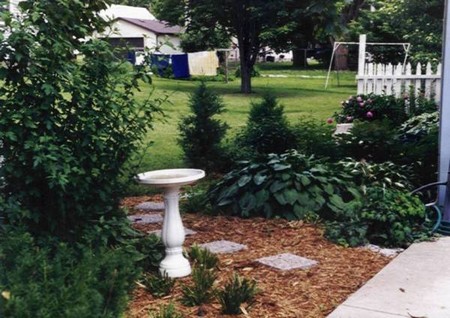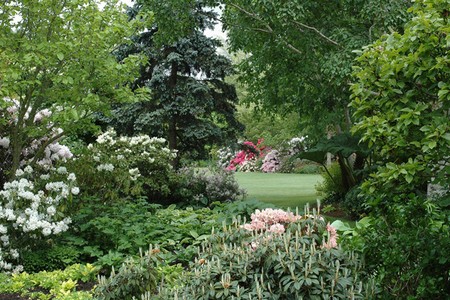If, like most Americans, you live in your house year-round, your garden is year-round, too. This situation is about as simple as it gets; the biggest threat your garden may have to face is your annual summer vacation, and there are ways of managing this successfully. Being at home year-round, you’ll be on the spot to take advantage of whatever good gardening days come along in earliest spring or latest fall. You can work around your job, on a reasonable schedule, on as many weekends as you want to or as are needed, plus some wonderful early mornings or evenings. I can think of something even better: you like to ski or go scuba diving (or anything else that can be done on a winter holiday), so that’s when you take your vacation, which means that you can be at home—and in the garden—all through the summer.
You could go along like this just fine until one day you decide you’re not living in the rural retreat you moved to some years back. It’s grown. You are now living in a “neighborhood,” and you yearn for real country. Next thing you know, you own a summer cottage in addition to your year-round house. The home garden has to look good while you’re there, in spring, fall, and winter. But what’s going to happen to it in summer while you’re at the lake, the beach, the mountains?
It gets more complicated. You love flowers, but summer is the time for flowers and that’s when you’re away, so there’s no point in planting at home, but perhaps a few annuals around the cottage . . . ? So there you are, gardening in two places miles, even hundreds of miles, apart. As many of us know, “getting away from it all” can turn into “taking it all with you.” If you’re in this situation, or are soon likely to be, you will have to plan carefully to take it into account.
One solution I can visualize, for example, is a garden that will be a delight from April to June, that will take care of itself through the hot months of July and August, and will have something to offer in fall when the owner returns. It would be a woodland garden that could be maintained with a reasonable amount of work.
If your garden already has trees, they will provide the strongest elements in it. You might make a lower tier by planting shrubs slightly forward of the trees. Choose shrubs for spring bloom, handsome foliage, or autumn color; you might even find some that will give you all three as Enkianthus campanulatus does.
Still further forward, plant spring bulbs, keeping to those that look most natural in a woodland setting. Tulips are not the flowers for this planting, but almost all the narcissus tribe are suitable. As long as the tree roots allow you to work up the soil sufficiently to make a good planting bed for the bulbs, don’t worry about shade from the trees. Their branches are still bare when the bulbs bloom, and once the leaf canopy is thick enough to throw shade the ripening bulbs will benefit. Another thing you won’t have to worry about is the yellowing foliage. It will have all summer to die down and either turn into a mulch or disappear entirely.
If you come across what I call a dead-loss spot, some corner of the garden that doesn’t seem to grow anything well, consider this a heaven-sent opportunity to put in some of the plants that make nuisances of themselves elsewhere. You could just give up, and plant a standard ground cover such as pachysandra, ivy, or myrtle, but wouldn’t it be nice to have white flowers illuminate this shady spot? I’m thinking of gooseneck loosestrife (Lysimachia clethroides). It’s a bit of a menace in flower borders, but here it could colonize and spread to its heart’s content. It would be attractive against the shrubs, its white flower spikes all pointing the same way, like the outstretched necks of a flock of geese. Assuming there is lawn in front, regular mowing will keep the loosestrife under control. The little Phlox stolonifera usually seen in soft blues and pinks, is available in a pure white, ‘Bruce’s White,’ which would be attractive here. I have clumps of it along the edge of a woodland, where it is exquisite first thing in spring, and hidden by ferns later in the season. It’s not called stolonifera for nothing; it spreads rapidly from stolons, runners, which is just what you need here.
As time goes on, you will come across more shrubs and shade plants that appeal to you, and between your additions and the plants’ growth, you will soon have a woodland scene, descending gracefully by tiers from the height of trees, down through shrubs to colonies of native plants, to ground cover, and, finally, to mown grass. Mowing the grass is about all that’s needed in this garden in July and August and that not very often. There are no flowers requiring vigilance against insects, no open beds requiring weeding, and by the time you close up the weekend place and are back home, early fall rain and cooler weather will have greened up the lawn nicely.
All you have to do in the autumn, then, is fuss around the shrubs, a bit of a snip here and a clip there, and enjoy the first sign of color change in the leaves. You can shred some of the fallen leaves and put them on the compost pile, but many can be left where they fall (except on the lawn). Each year, you can plant a few more bulbs.
In early spring, rake off concentrations of leaves, where they might smother emerging bulb shoots. This will be a good time to apply an all-purpose fertilizer (5-10-5 ratio) around the bulb plantings.
As for weeds, there will be some at first, among the shrubs and in the ground covers, but you don’t have to worry about them much, except to dig out any deep-rooted perennial weeds like dandelions and dock. A mulch of wood chips under the shrubs will help to suppress weeds.
Categories
Advertisements
Recent Articles
 How to Understand Bed Sizes – A Small Guide
How to Understand Bed Sizes – A Small Guide How to Select Some Must Have Kitchen Accessories
How to Select Some Must Have Kitchen Accessories Best Way to Change a Car Tire
Best Way to Change a Car Tire Best Way to Write an Affirmation
Best Way to Write an Affirmation Best Way to Take Charge of Your Financial Life
Best Way to Take Charge of Your Financial Life Best Way to Survive a Party When You Don’t Know Anyone
Best Way to Survive a Party When You Don’t Know Anyone Best Way to Stop Self Sabotaging Yourself
Best Way to Stop Self Sabotaging Yourself Best Way to Start Journal Writing
Best Way to Start Journal Writing Best Way to Speak with a Powerful Voice
Best Way to Speak with a Powerful Voice Best Way to Simplify Your Life
Best Way to Simplify Your Life Best Way to Respond to a Put-Down
Best Way to Respond to a Put-Down Best Way to Reduce Acne Breakouts
Best Way to Reduce Acne Breakouts Best Way to Recover from Dining Disasters
Best Way to Recover from Dining Disasters Best Way to Quit Your Job Gracefully
Best Way to Quit Your Job Gracefully Best Way to Make Your Own Website
Best Way to Make Your Own Website




Leave a Reply